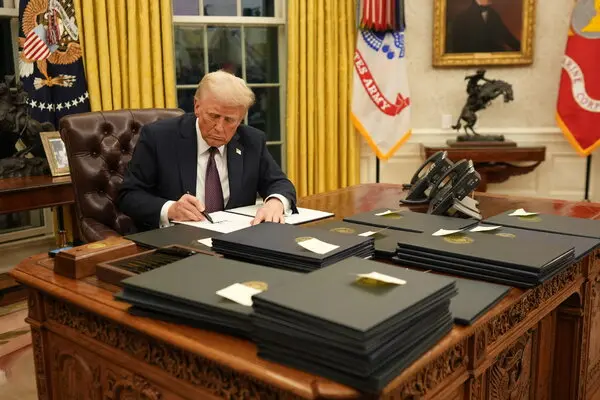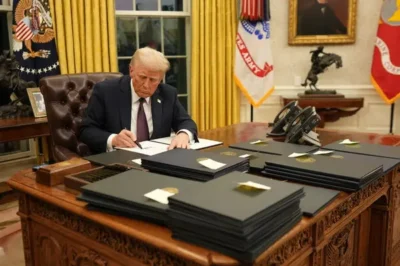
The Countdown to Tariffs and Uncertainty for Indian Businesses
As the April 2 deadline looms for US President Donald Trump to impose reciprocal tariffs on Indian goods, uncertainty hangs over numerous sectors. These tariffs are part of Trump’s broader strategy to address the significant trade deficit the US has with India. However, the exact impact on Indian businesses remains unclear, as the US moves toward renegotiating a fresh trade agreement with India. The critical question is whether these tariffs will be applied at the product level, sector level, or country level, which will drastically influence their effects.
US-India Trade Dynamics: A Vital Economic Partnership
From 2021-22 to 2023-24, the US emerged as India’s largest trading partner, accounting for about 18% of India’s total goods exports, 6.22% of its imports, and 10.73% of bilateral trade. This robust economic relationship spans a diverse range of sectors, with Indian exports to the US covering 30 industries – six in agriculture and 24 in manufacturing. The potential tariffs could disrupt this dynamic, posing challenges for sectors heavily reliant on the US market.
The Hardest Hit: Alcohol, Dairy, and Seafood Facing Steep Tariffs
If sector-level tariffs are implemented, certain industries will face disproportionate challenges. The alcohol, wine, and spirits sector will experience the highest tariff hike at 122.10%, despite exports totalling only $19.20 million. This steep increase could severely impact Indian exporters, reducing their competitiveness in the lucrative US market.
Dairy products, including ghee, butter, and milk powder, are also at risk. With $181.49 million in trade, a 38.23% tariff differential could make these products significantly more expensive for US consumers, leading to reduced demand and market share.
Similarly, the fish, meat, and processed seafood sector, valued at $2.58 billion, faces a 27.83% tariff hike. Shrimp, one of India’s key exports, will become considerably less competitive, threatening both large-scale exporters and small fishing communities reliant on international markets.
Impact on Live Animals and Processed Foods
The live animals and animal products sector will face a 27.75% tariff differential, affecting exports worth $10.31 million. While this may seem like a modest figure compared to other sectors, the impact on niche markets and specialized products can be significant.
Processed foods, sugar, and cocoa exports, totaling $1.03 billion, will also suffer under a 24.99% tariff increase. This could make Indian snacks, confectionery, and sugar-based products pricier in the US, reducing their attractiveness and potentially eroding market share.
Footwear, Jewellery, and Industrial Goods: The Ripple Effect
The footwear industry is another sector set to feel the pinch, with a high tariff differential of 15.56%. Indian footwear brands, which have been growing steadily in international markets, may find it harder to maintain their foothold in the US.
In the precious metals sector, diamonds, gold, and silver exports worth $11.88 billion will face a 13.32% tariff hike. This could lead to higher prices for Indian jewellery, making it less competitive compared to offerings from countries with more favorable trade terms.
Industrial goods, particularly pharmaceuticals, will also be affected. The pharmaceutical sector, crucial for India’s economy, faces a 10.90% tariff differential. This could raise the cost of generic medicines and specialty drugs, potentially impacting India’s reputation as a global hub for affordable healthcare solutions.
Edible Oils and the Sectors That May Escape New Tariffs
The edible oils sector, including coconut and mustard oil, will see a 10.67% tariff increase. While this may not seem as severe as other sectors, it could affect both small-scale producers and large exporters who rely heavily on the US market.
Interestingly, sectors like ores, minerals, petroleum, and garments are set to remain unaffected by the new tariffs. This provides some relief for industries that play a significant role in India’s export economy, ensuring continuity in their trade relationships with the US.
The Broader Economic Implications
The potential tariffs could have far-reaching effects beyond just the export numbers. Industries heavily dependent on the US market may face supply chain disruptions, job losses, and reduced foreign exchange earnings. Additionally, the ripple effect could lead to higher production costs for Indian manufacturers, potentially causing inflationary pressures domestically.
For Indian businesses, especially SMEs (small and medium enterprises), navigating the new trade landscape could be challenging. Many of these businesses lack the resources to absorb increased costs or to pivot to alternative markets quickly.
The Future of India-US Trade Relations
While the looming tariffs cast a shadow over Indian exports, there’s still room for optimism. The US is actively engaging in negotiations for a new trade agreement with India, which could potentially mitigate the impact of these tariffs. Both countries have vested interests in maintaining a strong economic partnership, given the strategic importance of their bilateral trade.
India’s government and industry stakeholders are likely to ramp up diplomatic efforts to negotiate favorable terms. The focus may shift towards leveraging India’s growing manufacturing capabilities, diversifying export markets, and enhancing the competitiveness of Indian products globally.
Conclusion: A Crucial Crossroads for Indian Exports As the April 2 deadline approaches, Indian businesses stand at a crucial crossroads. The prospect of reciprocal tariffs poses a significant challenge, but it also presents an opportunity to reassess and strengthen India’s trade strategies.
While the immediate impact may be painful for certain sectors, long-term reforms in manufacturing, diversification of export markets, and robust trade negotiations could help India weather the storm. The coming months will be pivotal in shaping the future of India-US trade relations, with global markets watching closely.









































Leave a Reply